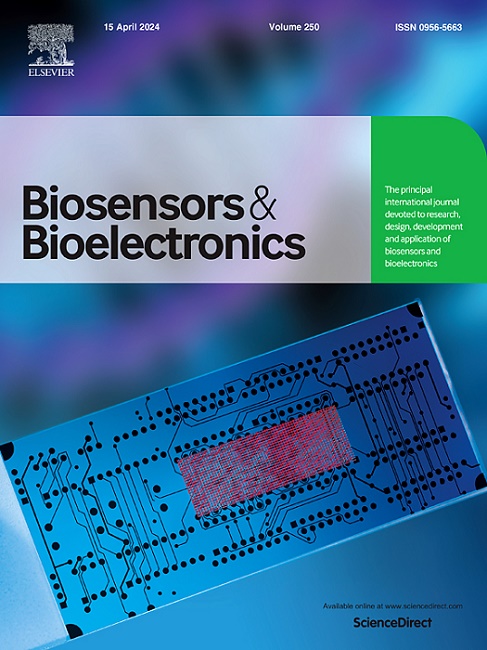基于深度学习算法的热响应和相分离水凝胶心律失常诊断
IF 10.5
1区 生物学
Q1 BIOPHYSICS
引用次数: 0
摘要
黏附表皮水凝胶电极对于实现稳健的信号转导和心律失常诊断至关重要,但由于缺乏可编程的改变黏附能力,传统黏附敷料的脱离容易对脆弱的伤口组织造成二次损伤。在此,我们开发了基于水凝胶的皮肤界面电极,能够按需可编程粘附和脱离,以捕获心电图信号以诊断心律失常。这是通过在相分离的智能水凝胶中通过温度介导的可切换氢键相互作用集成动态多尺度接触和协调调节来实现的。通过对粘附分子的微尺度调节和中尺度模量的调节,水凝胶电极在从皮肤剥离过程中可以在光滑状态(粘附力~ 1.3 N/m)和粘性状态(粘附力~ 110 N/m)之间快速过渡。与正常皮肤温度相比,在低温下,这实现了84.5倍的开/关粘合剂能量增加(或减少皮肤界面上98%的粘附)。通过集成水凝胶电极,开发了实时云平台,实现了远程心电图监测。在临床应用方面,该皮肤传感平台通过记录的高保真度和可分析的电信号,有效地捕获了八种常见心律失常患者的心脏活动。在深度学习算法的帮助下,我们展示了一种可穿戴式心律失常智能诊断系统,该系统能够将收集到的ECG数据实时转换为诊断评估,识别准确率为98.5%。本文章由计算机程序翻译,如有差异,请以英文原文为准。
Thermo-responsive and phase-separated hydrogels for cardiac arrhythmia diagnosis with deep learning algorithms
Adhesive epidermal hydrogel electrodes are essential for achieving robust signal transduction and cardiac arrhythmia diagnosis, but detachment of conventional adhesive dressings easily causes secondary damage to delicate wound tissues due to lack of programmable capability of changed adhesion. Herein, we developed hydrogel-based skin-interfacing electrodes capable of on-demand programmable adhesion and detachment to capture electrocardiogram signals for diagnosing cardiac arrhythmia. This was achieved by integrating dynamic multiscale contact and coordinated regulation through temperature-mediated switchable hydrogen bond interactions in phase-separated smart hydrogels. Through micro-scale regulation of adhesive molecules and meso-scale modulation of the modulus, the hydrogel electrodes can be rapidly transited between a slippery state (adhesion ∼1.3 N/m) and a sticky one (adhesion ∼110 N/m) during its peeling from skin. This achieves an 84.5-fold increase of on/off adhesive energy (or reducing the adhesion at the skin interface by 98%) at low temperatures compared to normal skin temperature. A real-time cloud platform was developed by integrating hydrogel electrodes, enabling remote electrocardiogram (ECG) monitoring. For clinical applications, such developed skin sensing platform effectively captured cardiac activities in patients with eight common arrhythmias, achieving by the recorded high-fidelity and analyzable electrical signals. With the assistance of deep learning algorithms, we demonstrated a wearable cardiac arrhythmia intelligent diagnosis system which enables real-time conversion of the collected ECG data into diagnostic evaluations with a recognition accuracy of 98.5%.
求助全文
通过发布文献求助,成功后即可免费获取论文全文。
去求助
来源期刊

Biosensors and Bioelectronics
工程技术-电化学
CiteScore
20.80
自引率
7.10%
发文量
1006
审稿时长
29 days
期刊介绍:
Biosensors & Bioelectronics, along with its open access companion journal Biosensors & Bioelectronics: X, is the leading international publication in the field of biosensors and bioelectronics. It covers research, design, development, and application of biosensors, which are analytical devices incorporating biological materials with physicochemical transducers. These devices, including sensors, DNA chips, electronic noses, and lab-on-a-chip, produce digital signals proportional to specific analytes. Examples include immunosensors and enzyme-based biosensors, applied in various fields such as medicine, environmental monitoring, and food industry. The journal also focuses on molecular and supramolecular structures for enhancing device performance.
 求助内容:
求助内容: 应助结果提醒方式:
应助结果提醒方式:


